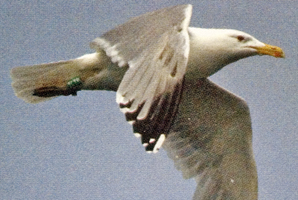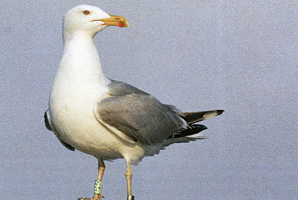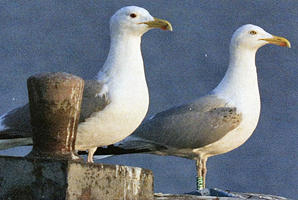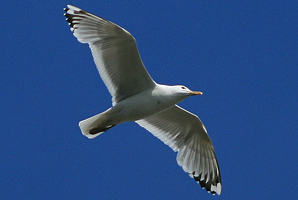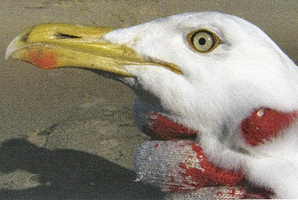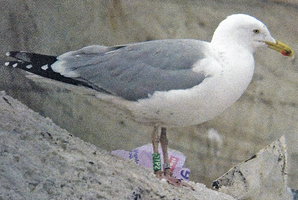 Larus cachinnans
Larus cachinnans
(last update:
Greg Neubauer
Marcin Przymencki
Albert de Jong
Mars Muusse
 sub-adult cachinnans: May
sub-adult cachinnans: May
In 2011, Chris Gibbins, Grzegorz Neubauer and Brian Small published two extensive papers in Britsih Birds, dealing with Caspian Gull. Below, you will find the content of the second paper "phenotypic variability and the field characteristics of hybrids".
The full title reads: From the Rarities Committee's files - Identification of Caspian Gull. Part 2: phenotypic variability and the field characteristics of hybrids, by Chris Gibbins, Grzegorz Neubauer and Brian Small, IN: BB 104/2011. ORDER PAPER COPY!
"we" in the text below refers to the original authors. If any errors occur in this text, please let me know and mail to marsmuusseatgmaildotcom.
PART 1: ABSTRACT & INTRODUCTION
PART 2: APPROACH
PART 3: ADULT BIRDS AND FIRST WINTER BIRDS
PART 4: DATA ANALYSIS
BELOW: PART 5 OF THE PAPER
Identification of Caspian Gull. Part 2: phenotypic variability and the field characteristics of hybrids
Variability in adult plumage
All the sample adult Caspian Gulls had less black than white on the outermost primary (P10), confirming that this is a relatively invariant feature in this species (table 3). Herring Gulls showed more variation, with a similar proportion of individuals falling into each score category. The pattern on the tip of P10 was variable in both species, but most Caspian Gulls showed either a pure white tip or a tip with just small black spots (scores 1 and 2). The colour of the tongue on P10 proved to be useful in separating the two species, as Caspian and Herring showed opposite patterns (fig. 5). All Caspian Gulls in the sample had white to pale grey tongues (scores 0 and 1), always paler than the mantle, while most Herring Gulls (37%) had a P10 tongue paler than the mantle, but still grey; birds showing white tongues were exceptional (just two individuals). An important point here is that a thayeri pattern (i.e. when the pale colour of the tongue breaks through the black to meet the white feather tip) can occur in both species. However, our sample indicates that when it occurs in Herring the tongue remains distinctly darker than the white tip, while in Caspian, because the tongue and tip are equally pale, the wing-tip has a very striking pied appearance.
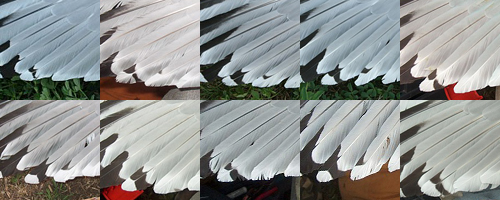
P4 & P5 patterns in Caspian Gulls from Włocławek Reservoir, central Poland. Pictures: Magdalena Zagalska-Neubauer. Birds captured as breeding adults. Click the links / ring codes to get larger images of all primaries and table 1 with scores for each wing (scoring by Mars Muusse, open for discussion):
upper row: 00P3, 01P1, 02P5, 03P5, 04P1.
lower row: 6P93, 07P1, 15P1, 17P1, 702P.
For example argenteus Herring Gulls from the Netherlands, see P4 & P5 scores HERE.
The patterns on P4 and P5 involve the inward extension of black in the primaries. On average, Herring Gulls have fewer primaries with black pigmentation than Caspian, and black portions on the equivalent inner primaries are thinner. Only one Herring Gull in the sample (i.e. <1%) had black on P4 (a single black spot on the outer web of the feather). In Caspian, 28% of birds had black markings on P4, mainly in the form of a single spot but one bird showed a complete band. Our data indicate that Caspian also has more black on P5: nearly all birds (77%) had at least a single spot, while the remaining birds showed a band on P5, either complete or broken; just one Caspian lacked any black on P5. In Herring Gull, 44% of birds had no black on P5 and many had either a single black spot (outer web, 27%) or an incomplete bar (20%) on P5. Individuals in the sample with complete bars on P5 were in general rare (9% in Herring, 8% in Caspian).

Sample argenteus Herring Gulls, trapped as breeding adults in the Netherlands and scored on peppering. Pictures: Theo Muusse. Note the yellow orbital eye-ring in all these birds. Click the links / ring codes to get larger images of complete head and upperwing and underwing (scoring by Mars Muusse, open for discussion):
upper row: male 13cy mint10, 14cy mintVE, female mint3K, male mint44.
lower row: 6y mint3T, male orangeH7, male orangeJ5, male orangeKN.
| Iris peppering | ||
| 0 | male orangeKN | dark-looking, >50% covered by dark spotting/peppering |
| 1 | male orangeJ5 | moderately dark, with 10-50% of the area spotted |
| 2 | female mint3K, male mint44, 6y mint3T, male orangeH7 |
single or very few dark spots (area < 10%) |
| 3 | male 13cy mint10, 14cy mintVE | no dark spotting on iris |
 Bare-part coloration
Bare-part coloration
Iris peppering differed strongly between species (table 3): no Herring Gulls had a strongly peppered iris (score 0), while nearly half the Caspians (47%) did so. None of the Caspian Gulls lacked dark spots on the iris completely, although 26% had relatively little peppering (score 2) and some of these birds would probably look pale-eyed in the field.
In terms of eye-ring coloration, perhaps the most striking statistic was the complete lack of Caspian Gulls in the sample showing a yellow eye-ring. Species shared the other two trait scores (dark / deep orange to red and pale to moderately orange), although it is also evident that, overall, Herring Gulls have a paler eye-ring and individuals that show a deep orange or red eye-ring are infrequent (6%).
Multivariate analyses and the character of hybrids
Overall patterns in the sum of all trait scores for adult gulls are shown in fig. 6. Caspian Gulls had consistently lower scores than Herring (mean values of 8.1 and 15.9 respectively) and the overall distribution of scores differed markedly between the two. Nonetheless, there was not complete separation – the highest-scoring Caspian and the two lowest-scoring Herring Gulls (1.2% of all birds) shared a score of 12. Hybrids had a range of intermediate scores that overlapped with both Herring and Caspian Gulls at the upper and lower parts of the distribution respectively.

Fig. 6. Sum trait scores for adult Caspian Larus cachinnans and Herring Gulls L argentatus, and hybrids. Scores are calculated by summing individual trait score values. The figure shows the percentage of individuals in the sample with a given sum value. Numbers in parentheses are the minimum and maximum values recorded.
An important point to bear in mind when interpreting the scores for individual birds is that a given sum score can result from different combinations of individual trait scores. Consequently, in themselves, the sum scores do not provide any insight into combinations of traits that might give rise to a bird being extreme or unusual in its overall character. This can be assessed using the PCA, however. Adult Herring and Caspian Gulls showed complete separation across the PCA biplot (fig. 7), with no overlap in the polygons which delimit the two species. This separation was across component (axis) 1, with Herring Gulls located to the left and Caspian Gulls to the right.
Arrows for several of the measured traits (notably P10 tongue colour, iris peppering and bill shape) sit more or less parallel to axis 1, indicating that they are primarily responsible for the separation of the species in this horizontal (left-to-right) dimension. The arrow for P5 is long, indicating that this feature differs markedly among sample birds. The P5 arrow sits very close to component (axis) 2. This indicates that the separation of sample birds in the vertical dimension is related primarily to variability in their P5 pattern. However, the fact that the two species do not separate in this dimension (i.e. there is no overall difference in the positions that the species occupy across axis 2) indicates that the extent of black on P5 does not differ systematically between them; consequently, this feature is not important for field identification. The arrow for the pattern on the P10 tip is also long and lies close to component 2, so again we conclude that while it differs between sample birds, it is not important in the separation of the two species.
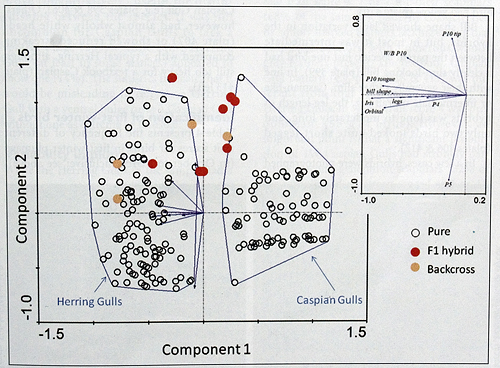
Fig. 7. PCA biplot showing sample adult Herring Larus argentatus and Caspian Gulls L cachinnans and a number of proven hybrids. Each circle represents a sample bird. Together, axes 1 and 2 explain 62.3% of the overall variance in the measured traits of the sample birds. Polygons group pure individuals of the two species, while hybrids are shown as coloured symbols. Trait arrows are shown on the main part of the figure (radiating from the origin); to avoid clutter; the inset shows the labels for these.
All ten known F1 hybrids included in the analysis showed a generally similar phenotype; across axis 1 of the PCA they were located in the area between the distributions of pure species, while several were separated from pure individuals in having high axis-2 scores. Detailed aspects of the phenotype of examples of some of these birds are discussed in respective plate captions (plates 396-413). An additional F1 hybrid, which could not be scored because details of its wing-tip were not visible, is shown in plate 406. While some hybrids were rather obvious as birds with intermediate phenotypes (e.g. P002), others (e.g. plate 399) were very Caspian-like. Unless extreme caution is applied and all important features are examined critically, birds such as that in plate 399 are easily misidentified as Caspian in the field.
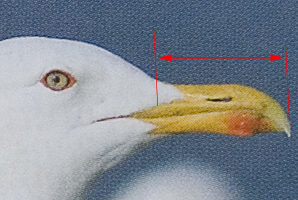 5cy male hybrid Caspian x Herring Gull, Wloclawek, central Poland, April 2009. Picture: Grzegorz Neubauer. Mother known as (yellow-legged) Herring, father as Caspian. Ringed as chick in Wloclawek, May 2005. Not all hybrids appear intermediate between their parent species: notice this bird’s striking resemblance to a Yellow-legged Gull. Its P10 pattern excludes Caspian (more black than white; see table 3), while its structure has intermediate scores between Herring and Caspian. Its overall score is 14, higher than that of any pure Caspian (which has a maximum of 12). This individual was discussed in Neubauer et al. (2010). |
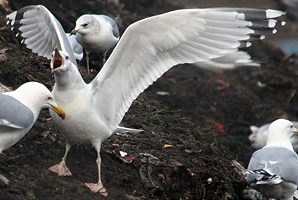 Larus cachinnans adult UKK T-00150x January 03 2008, central Austria. Picture: Wolfgang Schweighofer. An adult bird with partially read Ukraine ring (probably Dnjepr). Pale iris and completely lacking any black on P5. Greg Neubauer photographed a breeding adult Caspian Gull at Azov Sea, Ukraine, in May 2001. This bird also had only five black-tipped primaries. While this is very rare in Caspian (just a single bird amongst the 100 adults examined in the hand), such birds do occur in the core range of Caspian, as illustrated by these individuals. |
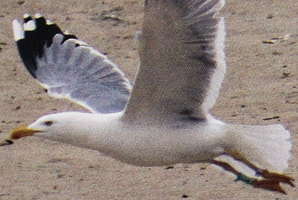 6CY hybrid Caspian x Herring Gull, Vistula, near Warsaw, Poland, May 2011. Ringed as chick on May 20 2006 in Wloclawek, central Poland. Mother known as Herring, father as Caspian. The P10 pattern of this bird was close to Caspian, with less black than white and a completely white tip to the feather: However, its bill was rather deep with a well-marked gonydeal angle, while its iris was non-spotted and its P10 tongue grey. These traits combined rule out a pure Caspian Gull. |
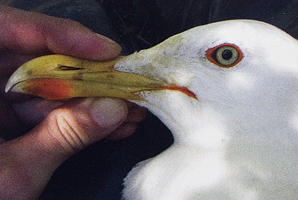 9CY female hybrid Caspian x Herring Gull, Przykona Reservoir, central Poland, May 2011 (trapped also in 2009). Picture: Thomas Iciek. Parents known as Herring (mother) and Caspian (father). This hybrid was ringed as a chick in May 2003 in Wloclawek, c. 80 km northeast of the colony where it bred in 2007-11. Bill ratio computed from depth/length measurements was 3.02, thus falling between Herring and Caspian (see Neubauer et al. 2007). Its overall score was 9, just on the safe limit for identification of Caspian. |
The proportion of black and white in P10 was variable in the hybrids: some showed more black than white (plates P002 & 170P) and others the opposite pattern (plate 4P60). Most hybrids had only small black dots at the tip of P10 and roughly one-third showed a complete or incomplete subterminal bar. The P10 tongue was most frequently as grey as the mantle (plates P002, 399 & 170P), but paler, approaching whitish, in other birds (plate 407). One of the F1 hybrids (plate 857P) had a wing-tip very like Caspian, with a deep P10 tongue, pure white tip and correct white to black proportions. The one feature that did not fit Caspian was its P10 tongue colour, which was similar in tone to the mantle. The inward extension of black in the wing-tip was quite variable in the adult hybrids, but all the sample birds had some black on P5 (single spots or, in most cases, an incomplete or complete bar). With respect to P4, the proportion of hybrids lacking black was similar to that of pure species (table 3), indicating that most often hybrids also had six black-tipped primaries.
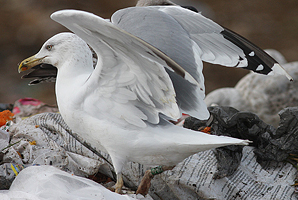 Hybrid Caspian x Herring Gull, green 4P60. Picture: Hannu Koskinen. Bird ringed as pullus on May 09 2004 at Wisla Wloclawek Tama, Poland. Bird from a mixed colony. Mother known as Caspian, father as Herring Gull. Ringed as a chick in the Wloclawek colony, Poland, May 09 2004. In many ways this bird shows classic intermediacy. Its bill is easily within the range of Caspian, but in adult plumage it has a Herring Gull-like pale eye and P10 pattern (more black than white). Its legs are yellow-toned, but this is of no real consequence. |
 Known male hybrid argentatus (mother) x cachinnans (father), 7CY. April 29 2009, Wloclawek - Vistula river, Poland. Picture: Magdalena Zagalska-Neubauer. Ringed as a chick in Wloclawek on May 22 2003. Note that the wing-tip is very Caspian-like (e.g. fully white tip to P10, more white than black in P10 and a full band across P5). However, it has a non-spotted iris, pale orange eye-ring and intermediate bill proportions; these features count against Caspian. Although hard to judge from this photograph, when computed from in-hand measurements the bill ratio was 2.69, too low for classic Caspian. Its overall score was 11, roughly halfway between the Herring and Caspian distributions, illustrating its intermediate phenotype. |
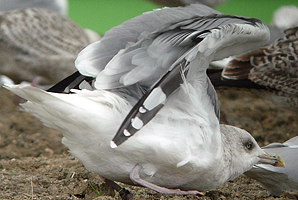 5CY hybrid Caspian x Herring Gull, Pohlsche Heide, Germany, October 12 2007. Picture: Armin Deutsch. Mother known as Caspian, father as Herring Gull. Its similarity to Caspian is evident in the structure (longish bill) and pale bill colour; on the other hand, its pale iris, P10 pattern and moderate head-streaking are all pro-Herring Gull traits. Overall, this bird is not eye-catching. It may go unnoticed, but if detected this combination of traits should preclude identification as a pure Caspian. |
 5CY Female F2 hybrid Caspian x Herring Gull, Pohlsche Heide, Germany, October 06 2009. Picture: Armin Deutsch. Parentage confirmed by microsatellite markers. Both parents were hybrids, trapped at the nest and identified in the hand by phenotype; the female parent had an intermediate genotype. Ringed as a chick in Wloclawek, central Poland, May 11 2005. Unlikely to be separated from Herring Gull with confidence, while pure Caspian can be excluded on the basis of the P10 pattern (very short tongue), the head shape and facial expression (notably the very pale eye). However, signs of Caspian genes include the longish legs, relatively slim bill and nearly all-white head, despite the fact that the moult to winter plumage is more or less finished. Despite it not being possible to calculate a total score for this bird (P4 and P5 patterns not visible), it must have been higher than 12 (this was the partial score without inclusion of P4 and P5). This score reflects the bird’s similarity to Herring (see fig. 6). |
Iris peppering was rather limited in most of the hybrids (91% had scores of 2 or 3), although it was moderate (score 1) in one backcross. Consequently, hybrids generally looked pale-eyed in the field. Notably, eye-ring colour was darker and more intense than in pure individuals of either species, including Caspian Gull. The coloration was deep orange to red in 57% of hybrids, while most of the remaining individuals had pale to moderate orange eye-rings and only one bird had yellow (6P01).
Bill shape showed large variation in the hybrids, but in most it was intermediate between the parent species; just one bird had a clearly slim-looking bill (plate 399). In line with their generally rather slim, Caspian-like or intermediate overall jizz, the leg length of hybrids was long to moderately long, and only two birds looked quite short-legged (plates 406 & 412).
In a few cases, hybrids were photographed in late autumn or early winter, and were thus in winter plumage. Some of these had heavy head-streaking, thus clearly excluding Caspian Gull (e.g. plates P002 & 406). Others, however, had almost wholly white heads (plate 407) or showed reduced streaking compared with a typical Herring, although still too heavy for a textbook Caspian (plate 07P2).
END OF PART 5
CONTINUE PART 6: IDENTIFICATION OF 1W BIRDS
 Larus cachinnans hybrid? 4CY 6P27 May 17 2007, Łubna landfill, Poland. Picture: Ruud Altenburg.
Larus cachinnans hybrid? 4CY 6P27 May 17 2007, Łubna landfill, Poland. Picture: Ruud Altenburg. 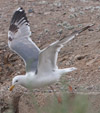 Larus cachinnans 4CY, May 30 2011, Aktogay, East-Kazakhstan Province (46,57N 79,40E). Picture: Gabor Papp.
Larus cachinnans 4CY, May 30 2011, Aktogay, East-Kazakhstan Province (46,57N 79,40E). Picture: Gabor Papp. Black on P3-P10, and on some secondary centres. P1 missing, P2-P10 old.
